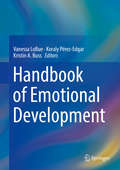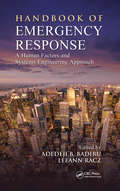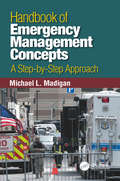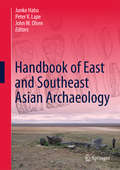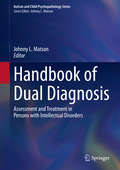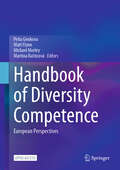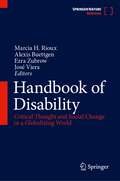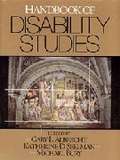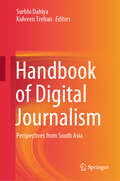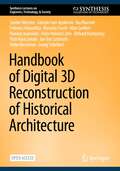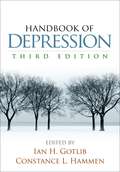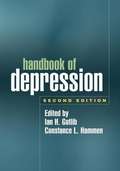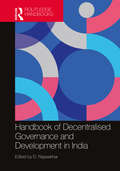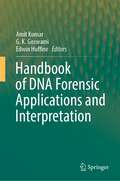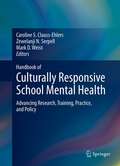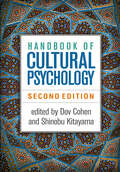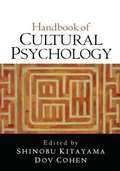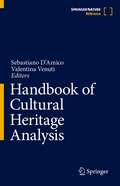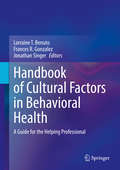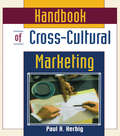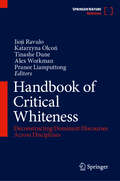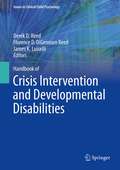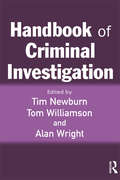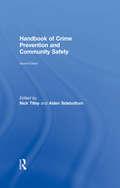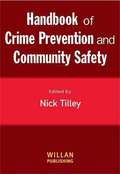- Table View
- List View
Handbook of Emotional Development
by Koraly Pérez-Edgar Vanessa LoBue Kristin A. BussThis handbook offers a comprehensive review of the research on emotional development. It examines research on individual emotions, including happiness, anger, sadness, fear, and disgust, as well as self-conscious and pro-social emotions. Chapters describe theoretical and biological foundations and address the roles of cognition and context on emotional development. In addition, chapters discuss issues concerning atypical emotional development, such as anxiety, depression, developmental disorders, maltreatment, and deprivation. The handbook concludes with important directions for the future research of emotional development. Topics featured in this handbook include:The physiology and neuroscience of emotions.Perception and expression of emotional faces.Prosocial and moral emotions.The interplay of emotion and cognition.The effects of maltreatment on children’s emotional development.Potential emotional problems that result from early deprivation. The Handbook of Emotional Development is an essential resource for researchers, clinicians/professionals, and graduate students in child and school psychology, social work, public health, child and adolescent psychiatry, pediatrics, and related disciplines.
Handbook of Emergency Response: A Human Factors and Systems Engineering Approach (Environmental and Occupational Health Series #27)
by Adedeji B. Badiru Leeann RaczDespite preemptive preparations, disasters can and do occur. Whether natural disasters, catastrophic accidents, or terrorist attacks, the risk cannot be completely eliminated. A carefully prepared response is your best defense. Handbook of Emergency Response: A Human Factors and Systems Engineering Approach presents practical advice and guidelines
Handbook of Emergency Management Concepts: A Step-by-Step Approach
by Michael L. MadiganThis book provides a step-by-step process that focuses on how to develop, practice, and maintain emergency plans that reflect what must be done before, during, and after a disaster, in order to protect people and property. The communities who preplan and mitigate prior to any incident will be better prepared for emergency scenarios. This book will assist those with the tools to address all phases of emergency management. It covers everything from the social and environmental processes that generate hazards, to vulnerability analysis, hazard mitigation, emergency response, and disaster recovery.
Handbook of East and Southeast Asian Archaeology
by Junko Habu Peter V. Lape John W. OlsenThis Handbook focuses on the material culture and lifeways of the peoples of prehistoric and early historic East and Southeast Asia, their origins, behavior and identities as well as their biological, linguistic and cultural diversity and commonalities. Emphasis is placed upon the interpretation of material culture to illuminate and explain social processes and relationships as well as behavior, technology, patterns and mechanisms of long-term change and chronology in addition to the intellectual history of archaeology as a discipline in this diverse region. The Handbook of East and Southeast Asian Archaeology augments archaeologically-focused chapters contributed by regional scholars by providing histories of research and intellectual traditions and by maintaining a broadly comparative perspective. Archaeologically-derived data are emphasized with text-based documentary information provided to complement interpretations of material culture. The Handbook is not restricted to art historical or purely descriptive perspectives; its geographical coverage includes the modern nation-states of China, Mongolia, Far Eastern Russia, North and South Korea, Japan, Taiwan, Vietnam, Cambodia, Laos, Thailand, Burma, Malaysia, Indonesia, the Philippines and East Timor.
Handbook of Dual Diagnosis: Assessment and Treatment in Persons with Intellectual Disorders (Autism and Child Psychopathology Series)
by Johnny L. MatsonThis handbook addresses behavior problems and mental health disorders in persons with intellectual disabilities. It provides an overview of the history of dual diagnosis and related theories, ethics, diagnostic systems, mental health disorders, and challenging behaviors. The handbook examines general clinical issues, such as the effects of cognitive performance on the choice of assessment and treatment methods, service delivery systems, education models, risk factors, functional assessment, and structured interviews. Chapters provide a much-needed reference for practitioners and practitioners in training. The applied focus of the book continues with assessment/diagnosis sections of mental health disorders, and challenging behaviors. In addition, chapters describe treatments for discrete mental health and behavior problems, such as intellectual disabilities, severe psychopathology, autism, ADHD, substance abuse, and aggression. Topics featured in this handbook include: Genetic disorders and dual diagnosis. Assessment of anxiety in persons with dual diagnosis. Aging with intellectual disabilities. Feeding problems and assessment in individuals with dual diagnosis. Pica in individuals with intellectual disability. Treatment of social skills in dual diagnosis. The Handbook of Dual Diagnosis is an essential reference for researchers, graduate students, clinicians and related therapists and professionals in clinical child and school psychology, child and adolescent psychiatry, social work, developmental psychology, behavioral therapy/rehabilitation, pediatrics, and special education.
Handbook of Diversity Competence: European Perspectives
by Michael Morley Petia Genkova Matt Flynn Martina RašticováThis open access handbook provides the most current overview of the discussion on diversity competence, with a focus on Europe. Diversity competence has become a key area of interdisciplinary study because of the increasingly intercultural nature of institutions and organisations across the world. This important handbook reviews the conceptual and theoretical foundations of this concept and reflects on the scope of its application. It provides directions for further research in the theory, research and practice of diversity competence and includes country-wise perspectives as well. An international team of researchers brings together insights from research and best practice in psychology, cultural sciences, economics, pedagogical sciences, sociology, social work, medicine, theology, politics and law. This is an important resource for a wide readership of students, researchers and practitioners who research on or work with people from diverse cultures.
Handbook of Disability: Critical Thought and Social Change in a Globalizing World
by Ezra Zubrow Marcia H. Rioux Alexis Buettgen José VieraThis important reference work maps the terrain of disability across the world by providing an overview of issues, concerns and developments in the domains of society, culture, medicine, law, policy, justice, education, economics, and science and technology. It is a truly inclusive volume bringing together perspectives from researchers, activists, professionals, service providers, international development experts and policymakers based in the global North and South, and it particularly focuses on the voices of the principal stakeholders---disabled persons themselves. Working from an interdisciplinary matrix, this book reviews historical developments, contemporary practices and policies . It addresses hitherto unchartered areas in the disability discourse that will be significant in the years to come. In the modern world, the social and medical responses to disability have been separation, segregation and incarceration of disabled people. These responses are reflected in practices of special education, building of asylums, medical classifications and sheltered employment. Current thinking on disability is based on the need to overcome such segregation through the enactment of human rights and socially just programmes, policies and laws such as inclusive education, affirmative action, reasonable accommodation, and supported decision-making. This book explores:· The evolution of the concept of disability over space and time and identifies approaches to disability, debility, equality and equity;· Broad trends in research on disability across the world;· New directions in work on disability;· The emergence of a global disability movement and its etiology;· Intersections of disability with other demographic variables like gender, race, caste, and age; and· Historical and socio-economic interfaces with colonialism, globalization, and social development. Spread over14 sections and spanning more than 80 chapters, this volume is the most comprehensive, up-to-date reference work available on the subject.
Handbook of Disability Studies
by Gary L. Albrecht Katherine D. Seelman Michael BuryDrawing on the insights of disability scholars around the world and the creative advice of an international editorial board, this book engages the reader in the critical issues and debates framing disability studies and places them in an historical and cultural context. Five years in the making, this one volume summarizes the ongoing discourse ranging across continents and traditional academic disciplines.
Handbook of Digital Journalism: Perspectives from South Asia
by Surbhi Dahiya Kulveen TrehanThis book presents perspectives from South Asian countries, such as India, Nepal, Sri Lanka, Bangladesh, and Bhutan. It brings in-depth perspectives on content, communication, and community between communication theory and the digital news ecosystem rooted in a South Asian culture-centric approach. The book thoroughly investigates changes in the regulatory framework, regulations, policies, and code of conduct. It engages debates on digital journalism practices modeled around mobile journalism, immersive storytelling, and gamification in the context of local and hyper-local communities in South Asia. The book provides a cohesive compilation offering readers an up-to-date and comprehensive understanding of digital developments in journalism. It also helps journalists and practitioners working in news media to discover new types of information flows in a rapidly changing news media landscape.Digital Journalism: Perspectives from South Asia is a descriptive, exploratory book on digital journalism practices and policies followed in India, Nepal, Sri Lanka, Bangladesh, and Bhutan. It brings in-depth perspectives on content, communication, and community between communication theory and the digital news ecosystem rooted in a South Asia. What makes this book interesting to read is the integration of forms with manifestations on ground intersecting identities and ideologies. The book thoroughly investigates changes in the regulatory framework, regulations, policies, and code of conduct. Various chapters in the book pursue significant and exciting topics on the changing spaces of news production and consumption, the inter relationship between old and new media, everyday digital news usage and engagement, social media for news, revenue models for digital journalism among others. The highlight of this book is engaging debates on digital journalism practices modeled around mobile journalism, immersive storytelling, gamification, in the context of local and hyper local communities in South Asia. Since Digital Journalism draws extensively from algorithms, matrices and analytics, this book has exclusive chapters on data journalism, data visualization and big data.. The book provides a cohesive compilation offering readers an up-to-date and comprehensive understanding of digital developments in journalism. It also helps journalists and practitioners working in news media to discover new types of information flows in a rapidly changing news media landscape. It also articulates indegenous concerns of journalists, their security, risks and challenges as they explore the new contours of journalistic practices.
Handbook of Digital 3D Reconstruction of Historical Architecture (Synthesis Lectures on Engineers, Technology, & Society #28)
by Sander Münster Piotr Kuroczyński Marinos Ioannides Heike Messemer Fabrizio Ivan Apollonio Ina Bluemel Federico Fallavollita Riccardo Foschi Marc Grellert Peter Heinrich Jahn Richard Kurdiovsky Jan-Eric Lutteroth Georg SchelbertThis open access book is a handbook for students, experts and interested parties who want to learn more about digital 3D reconstruction of historical architecture. The book provides answers to the core questions of the subject: What is a digital 3D model or a digital 3D reconstruction? How are they created and what are they used for? Practical instructions, condensed knowledge, explanations of technical terms and references to example projects, literature and further references provide information of varying density and thus enable an individual introduction to the subject.The book combines extensive knowledge on the topic of "digital 3D reconstruction of historical architecture" and provides practical instructions for independent implementation. Up to now, there has been no cross-disciplinary vocabulary for technical terms in this field, so this publication makes a start.The book is aimed at students, experts in the field and the interested public and offers various possibilities for the different target groups to delve deeply into the subject.The book was created within the research network "Digital 3D Reconstruction as Tools for Research in Architectural History," which was funded by the German Research Foundation (DFG) from 2018 to 2023. The authors combined their expertise in the fields of art and architectural history, architecture, university teaching and media informatics.
Handbook of Depression, Third Edition
by Constance L. Hammen Ian H. GotlibThe authoritative reference on depression and mood disorders, this volume brings together the field's preeminent researchers. All aspects of unipolar and bipolar depression are addressed, from genetics, neurobiology, and social-contextual risk factors to the most effective approaches to assessment and clinical management. Contributors review what is known about depression in specific populations, exploring developmental issues across the lifespan as well as gender and cultural variables. Effective psychosocial and biological treatments are described in detail. Each chapter offers a definitive statement of current theories, methods, and findings, and identifies key questions that remain to be answered. New to This Edition *Incorporates cutting-edge research (including findings from international, multisite, integrative, and longitudinal studies), treatment advances, and changes to diagnostic criteria in DSM-5. *Chapters on comorbidity with anxiety disorders and emotional functioning in depression. *Expanded coverage of bipolar disorder, now the focus of three chapters (clinical features, risk and etiological factors, and treatment). *Many new authors and extensively revised chapters.
Handbook of Depression, Second Edition
by Ian Gotlib Constance HammenBringing together the field's leading authorities, this acclaimed work is widely regarded as the standard reference on depression. The Handbook provides comprehensive coverage of the epidemiology, course, and outcome of depressive disorders; issues in assessment and diagnosis; psychological and biological risk factors; effective approaches to prevention and treatment; and the nature of depression in specific populations. Each chapter offers a definitive statement of current theories, methods, and research findings, while also identifying key questions that remain unanswered.
Handbook of Decentralised Governance and Development in India
by D. RajasekharThis handbook examines 25 years of decentralised governance and development in India. It provides a historical overview of developments since the introduction of decentralisation reforms (73rd and 74th Constitutional Amendment Acts) and critically assesses the measures initiated to strengthen decentralised institutions and deepen grassroots democracy. It also discusses the status of service delivery and identifies the issues and challenges involved in achieving development at the local level. The volume studies themes such as the devolution of powers in India, administrative and fiscal decentralisation, decentralised planning, Panchayats in scheduled areas, the sociological aspects of decentralisation, caste, gender and local democracy, capacity building, ICT for local governance, urban local governance, workfare and decentralisation, and decentralised natural resource management. It also looks at Panchayati Raj institutions from a Gandhian perspective. The first of its kind, this handbook will be an essential read for scholars and researchers of decentralisation and development, development studies, fiscal decentralisation, political studies, political sociology, Indian politics, Indian government, public policy and governance, political economy, South Asian studies, and South Asian politics.
Handbook of DNA Forensic Applications and Interpretation
by Amit Kumar G. K. Goswami Edwin HuffineThis handbook covers tested and proven DNA forensic testing methodologies, forensic bioinformatics techniques, case studies and current forensic legal framework for investigation of variety of crimes and provides a clinching evidence for speedy justice. DNA testing is widely used for forensic purposes and is changing the paradigm of (crime) investigation. The book contains chapters on usage of ultramodern DNA collection kits, presents era evidence collection and preservation, high-end DNA sample analysis in laboratory, DNA legislation, expert evidences, challenging and successful case studies, data generation and application of AI and IoT techniques for DNA data analysis, DNA databanks and training manpower to facilitate timely reporting to the requesting agencies. This handbook equips and enables police, investigators and crime analysis laboratories with knowhow of high-end tools, procedures and techniques to link or exclude a criminal to a crime. It is expected that this will be used by first responders, police, forensic analysts, judiciaries, evidence handlers and students and scholars of criminology and forensic sciences worldwide. The intention to write this handbook is to make DNA technology and its importance reach every common man and professional for correctly using it as a tool as and when required. This is quite evident that awareness of DNA technology has increased at a reasonable pace. Courts and investigating agencies are convinced and confident with its accuracy, reliability and unmatched peace delivered by various techniques of DNA fingerprinting and DNA profiling.
Handbook of Culturally Responsive School Mental Health
by Mark D. Weist Zewelanji N. Serpell Caroline S. Clauss-EhlersSchools across the United States - as well as much of the world - are experiencing widespread change. Students are more diverse ethnically, academically, and emotionally. More attention is being paid to abuse and neglect, violence and bullying, and the growing inequities that contribute to student dropout. Within this changing landscape, cultural competence is imperative for school-based professionals, both ethically and as mandated by educational reform. The Handbook of Culturally Responsive School Mental Health explores the academic and behavioral challenges of an increasingly diverse school environment, offering workable, cost-effective solutions in an accessible, well-organized format. This timely volume updates the research on cultural competence in school-based interventions, describes innovative approaches to counseling and classroom life, and demonstrates how this knowledge is used in successful programs with children, adolescents, and their families. Populations covered range widely, from African American and Asian American/Pacific Islander families to forced migrants and children who live on military bases. By addressing issues of training and policy as well as research and practice, contributors present a variety of topics that are salient, engaging, and applicable to contemporary experience, including: - Adolescent ethnic/racial identity development. - Culturally responsive school mental health in rural communities. - Working with LGBT youth in school settings. - Cultural competence in work with youth gangs. - Culturally integrated substance abuse prevention and sex education programs. - Promoting culturally competent school-based assessment. - School-based behavioral health care in overseas military bases. - Developmental, legal, and linguistic considerations in work with forced migrant children. - Cultural considerations in work/family balance. The Handbook of Culturally Responsive School Mental Health is a must-have reference for researchers, scientist-practitioners, educational policymakers, and graduate students in child and school psychology; educational psychology; pediatrics/school nursing; social work; counseling/therapy; teaching and teacher education; and educational administration.
Handbook of Cultural Psychology, Second Edition
by Shinobu Kitayama Dov CohenNow completely revised (over 90% new), this handbook offers the authoritative presentation of theories, methods, and applications in the dynamic field of cultural psychology. Leading scholars review state-of-the-art empirical research on how culture affects nearly every aspect of human functioning. The volume examines how topics fundamental to psychology--such as cognition, emotion, motivation, development, and mental health--are influenced by cultural meanings and practices. It also addresses the psychological and evolutionary underpinnings of cultural stability and change. The second edition reflects important advances in cultural neuroscience and an increasing emphasis on application, among many other changes. As a special bonus, purchasers of the second edition can download a supplemental e-book featuring several notable, highly cited chapters from the first edition. New to This Edition: *Most chapters are new, reflecting nearly a decade of theoretical and methodological developments. *Cutting-edge perspectives on culture and biology, including innovative neuroscientific and biopsychological research. *Section on economic behavior, with new topics including money, negotiation, consumer behavior, and innovation. *Section on the expansion of cultural approaches into religion, social class, subcultures, and race. *Reflects the growth of real-world applications in such areas as cultural learning and adjustment, health and well-being, and terrorism.
Handbook of Cultural Psychology
by Shinobu Kitayama Dov CohenBringing together leading authorities, this definitive handbook provides a comprehensive review of the field of cultural psychology. Major theoretical perspectives are explained, and methodological issues and challenges are discussed. The volume examines how topics fundamental to psychology-identity and social relations, the self, cognition, emotion and motivation, and development-are influenced by cultural meanings and practices. It also presents cutting-edge work on the psychological and evolutionary underpinnings of cultural stability and change. In all, more than 60 contributors have written over 30 chapters covering such diverse areas as food, love, religion, intelligence, language, attachment, narratives, and work.
Handbook of Cultural Heritage Analysis
by Sebastiano D’Amico Valentina VenutiThis Handbook covers non-invase techniques as well as digital technologies to study cultural heritage. It focuses on multidisciplinary approaches that help site managers to deal with their site form conservation to prevention. The book is conceived to foster exchanges of ideas and information and to update innovation on measurements suitable for cultural heritage across several disciplines. Contributions on measurements deriving from the large number of analytical methodologies and tools (spectroscopy, chemometrics, modeling, etc) are also of interest for the scientific community. Considering the tremendous amount of new interactive technologies which inevitably impact traditional arts, the final section of the Handbook focuses on the use of virtual reality systems in museums and archaeological sites. The Handbook will contribute to build an international network of cultural heritage scientists, architects, geophysicists, archaeologists, and soil scientists.
Handbook of Cultural Factors in Behavioral Health: A Guide for the Helping Professional
by Lorraine T. Benuto Jonathan Singer Frances R. GonzalezHaving the knowledge and capacity to deliver therapy to a diverse population is recognized as benefiting client-therapist relationships and producing positive clinical outcomes. In fact, the APA requires that psychologists be aware of and respect the cultural characteristics of their clients which includes psychologists being aware of any biases and prejudice they may hold. Being aware of cultural characteristics, which include age, gender, ethnicity, race, religion and other cultural factors, is important. In the United States, minority ethnic groups are growing substantially, with 28% of the U.S. population identifying as races other than white (U.S. Census, 2016). Additionally, approximately 65 million people in America speak a foreign language that is not English, with over 25 million people having limited English language proficiency. With a diverse pool of clients, helping professionals should be better prepared to work with diverse clients. This handbook offers clinicians a comprehensive resource with which to work with diverse populations.The myriad discussions among the chapters include:Ethical guidelines for working with culturally diverse clientsCultural considerations in psychological assessment and evaluation Behavioral health service delivery with culturally diverse clientsCross-cultural factors in the treatment of trauma related disordersCultural considerations in the assessment and behavioral treatment of substance use disorders Handbook of Cultural Factors in Behavioral Health expertly offers clinicians a comprehensive set of resources and tools that will assist them working with diverse clients. Clinicians working with culturally diverse clients, as well as researchers and students learning about how cultural factors are relevant to the helping profession will all find this volume an integral addition to their library.
Handbook of Cross-Cultural Marketing
by Erdener Kaynak Paul HerbigGoing global can be risky business if you don't divest yourself of your ethnocentric thinking. You have to take into consideration your new market's language, work schedules, tastes, lifestyle choices, and cultural associations, and this is the book to help you do that! Handbook of Cross-Cultural Marketing shows you how to sensitize your marketing approaches to the cultural norms and taboos of other societies, as well as the importance of demonstrating an interest in and appreciation of different cultures.Designed to assist both American and foreign companies, Handbook of Cross-Cultural Marketing shows you how to increase your chance at success in international markets. It identifies and explains ten important aspects of culture that are essential to cross-cultural marketing to help you understand how underlying cultural beliefs govern the way marketing functions in different societies. It also gives you specific steps for developing cultural adaptation strategies in international marketing. To further your understanding of global marketing and fundamental marketing concepts, this comprehensive book discusses:real life examples of company successes and failures abroadattitudes toward middlemen in underdeveloped countriesthe advantages of foreign trade showslocating and using representatives, agents, and/or distributors in foreign countriesthe reception of different American products in different countriespotential cultural pitfalls of primary data collecting techniquesthe role of time in various culturessetting standards for product performanceA useful text for students and practitioners alike, Handbook of Cross-Cultural Marketing gives you hands-on strategies and advice for delving into different markets, using techniques that are respectful of individual cultures, and avoiding unnecessary mistakes that can occur if you don't take the initiative to get to know the culture of your new marketplace. Your outlook and beliefs are not the global norm, so read this book to find out how you can be successful with customers who are different from you in terms of motivation, values, beliefs, and outlook.
Handbook of Critical Whiteness: Deconstructing Dominant Discourses Across Disciplines
by Pranee Liamputtong Tinashe Dune Jioji Ravulo Alex Workman Katarzyna OlcońThis timely handbook responds to the international drive to know more about Whiteness – its origins, its impacts and, importantly, the means for diffusing it. Guided by critical Whiteness theory, the volume deconstructs, decodes and disrupts Whiteness as it is constructed and employed in contemporary and diverse contexts. To do so, the international contributors discuss and critique the role of 21st-century Whiteness across a range of professions and disciplines relevant to the needs of contemporary global citizens. Failure to deconstruct Whiteness as an ideology and the power structure underlying national and global racial inequalities undermines the efforts to improve social, health and economic outcomes for societies and nations on a grand scale. The handbook is comprehensive in its nature and contents, with 10 themed parts ranging from a more disciplinary-based approach, theoretical frameworks, and methodological frameworks, to different aspects of decolonized approaches to social, health, political and economic well-being. It navigates how various disciplines respond to the pervasive and persuasive nature of Whiteness in their operational settings, across individual, professional, organisational and systemic levels. The volume is unique in its dual focus on deconstructing Whiteness and providing examples and recommendations on how diverse groups seek to decolonize their communities and people through action. Examples and recommendations are discussed with particular focus on: 1) the interconnection between integrating indigenous and diverse knowledges and perspectives in deconstructing Whiteness; 2) the urgency for critical Whiteness discourse, dialogue and professional development across disciplines; and 3) institutional accountability to decolonisation and anti-racism. Considering the ongoing marginalization and institutional racism directed at non-White individuals and communities and the rise of White supremacy movements, critical Whiteness pedagogy and research is more important than ever. Handbook of Critical Whiteness: Deconstructing Dominant Discourses Across Disciplines is an essential resource for students, educators, academics, researchers, higher education administrators, practitioners, policy-makers, organisational leaders, government stakeholders, and other professionals in social sciences, medicine, STEM, allied/global/public health, legal and political disciplines, and health and social care institutions. It especially engages those interested in decolonisation, critical race theory, critical Whiteness theory, critical multiculturalism, social justice, anti-racism and Indigenous knowledges.
Handbook of Crisis Intervention and Developmental Disabilities
by James K. Luiselli Derek D. Reed Florence D. DiGennaro ReedThe Handbook of Crisis Intervention and Developmental Disabilities synthesizes a substantive range of evidence-based research on clinical treatments as well as organizational processes and policy. This comprehensive resource examines the concept of behavioral crisis in children and adults with special needs and provides a data-rich trove of research-into-practice findings. Emphasizing continuum-of-care options and evidence-based best practices, the volume examines crisis interventions across diverse treatment settings, including public and private schools, nonacademic residential settings as well as outpatient and home-based programs. Key coverage includes: Assessment of problem behaviors.Co-occurring psychiatric disorders in individuals with intellectual disabilities.Family members' involvement in prevention and intervention.Intensive treatment in pediatric feeding disorders.Therapeutic restraint and protective holding.Effective evaluation of psychotropic drug effects. The Handbook of Crisis Intervention and Developmental Disabilities is a must-have resource for researchers, scientist-practitioners, and graduate students in clinical child, school, developmental, and counseling psychology, clinical social work, behavior therapy/analysis, and special education as well as other related professionals working across a continuum of service delivery settings.
Handbook of Criminal Investigation
by Tim Newburn Alan Wright Tom WilliamsonThis book provides the most comprehensive and authoritative book yet published on the subject of criminal investigation, a rapidly developing area within the police and other law enforcement agencies, and an important sub discipline within police studies. The subject is rarely out of the headlines, and there is widespread media interest in criminal investigation. Within the police rapid strides are being made in the direction of professionalizing the criminal investigation process, and it has been a particular focus as a means of improving police performance. A number of important reports have been published in the last few years, highlighting the importance of the criminal investigation process not only to the work of the police but to public confidence in this. Each of these reports has identified shortcomings in the way criminal investigations have been conducted, and has made recommendations for improvement . The Handbook of Criminal Investigation provides a rigorous and critical approach to not only the process of criminal investigation, but also the context in which this takes place, the theory underlying it, and the variety of factors which influence approaches to it. It will be an indispensable source of reference for anybody with an interest in, and needing to know about, criminal investigation. Contributors to the book are drawn from both practitioners in the field and academics.
Handbook of Crime Prevention and Community Safety
by Nick Tilley Aiden SidebottomThis second edition of the Handbook of Crime Prevention and Community Safety provides a completely revised and updated collection of essays focusing on the theory and practice of crime prevention and the creation of safer communities. This book is divided into five comprehensive parts: Part I, brand new to this edition, is concerned with theoretical perspectives on crime prevention and community safety. Part II considers general approaches to preventing crime, including a new chapter on the theory and practice of deterrence. Part III focuses on specific crime prevention strategies, including a new chapter on regulation for crime prevention. Part IV focuses on the prevention of specific categories of crime and the fear they generate, including new chapters on organised crime and cybercrime. Part V considers the preventative process: the methods through which presenting problems can be analysed, responses formulated and implemented, and their effectiveness evaluated. Bringing together leading academics and practitioners from the UK, US, Australia and the Netherlands, this volume will be an invaluable reference for researchers and practitioners whose work relates to crime prevention and community safety, as well as for undergraduate and postgraduate courses in crime prevention.
Handbook of Crime Prevention and Community Safety
by Nick TilleyThis book provides a comprehensive, authoritative and wide-ranging account of the background, theory and practice of crime prevention and community safety. It will be essential reading for anybody with interests in these fields, and will be the major work of reference on this subject for those engaged in the practice, study or teaching of crime prevention. The book provides a detailed overview of the main theories and perspectives informing crime prevention policy and practice, and includes chapters covering efforts to address a number of the main types of crime problem. It also includes chapters relating to research methodologies used in conducting and evaluating crime prevention initiatives.
